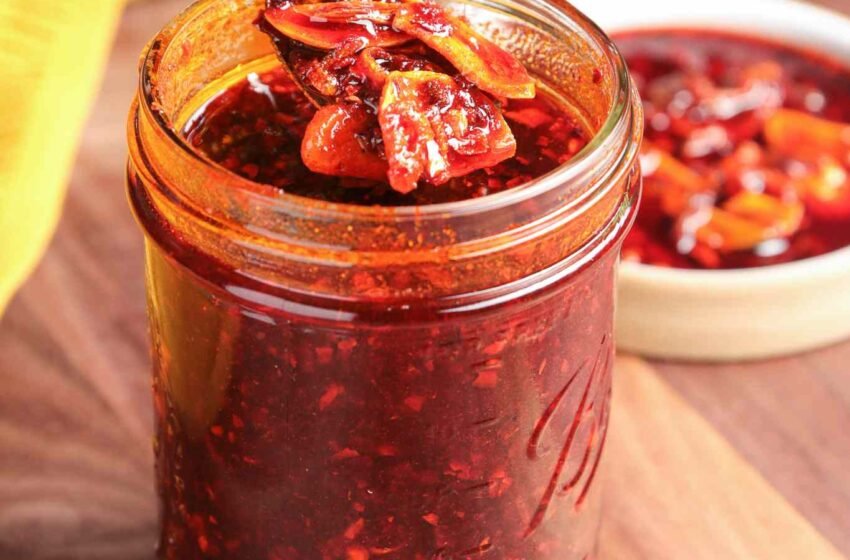Homemade chili crisp is one of the most delicious condiments that you can make at home. This recipe not only adds a vibrant red color to your food, but it also packs a flavorful punch thanks to a variety of chili peppers. Fried shallot rings and garlic chips lend a crispy and crunchy texture.
While it is red and peppery, this chili crisp isn’t too hot, providing a delicious kick without being overly intense. You can also adjust the recipe to your liking depending on your spice tolerance.
Chili crisp just adds a touch of saltiness, umami, and spice while making food look so fun and exciting.
Simply Recipes / Frank Tiu
Chili Crisp vs. Chili Oil vs. Chili Crunch
Although chili crisp, chili oil, and chili crunch share similarities, there are noteworthy differences between them. All three products use a neutral oil base combined with various peppers, garlic, and spices.
- Chili oil primarily consists of oil with some pepper and spice sediments and may be made with additional toppings such as soybean, black bean, or peanuts for added flavor. It adds flavor and heat to a dish without adding extra texture.
- Chili crisp, on the other hand, can feature ingredients like fried shallots and garlic alongside a generous amount of chili flakes. The toppings provide the iconic crispy texture, with chili oil filling in the gaps. Compared to chili oil, chili crisp contains significantly more toppings by volume.
- Chili crunch takes chili crisp a step further by adding crunchy texture with the addition of fried whole peanuts, chopped peanuts, soybeans, and/or sesame seeds.
Adjusting the Spice Level In Chili Crisp
Although this recipe features a blend of various peppers including Sichuan peppercorn, cayenne red pepper flakes, Japones dried chili pepper, and gochugaru (Korean chili pepper powder), the majority of the spiciness comes from gochugaru.
For a more intense and robust flavor, you can add more gochugaru to your liking. For those who prefer a milder heat level, you can reduce or substitute gochugaru with paprika or more red pepper flakes.
While Sichuan peppercorn is known for its numbing and spicy flavor, it is used in this recipe in moderation to provide floral notes and depth of flavor. It’s entirely optional, so you can omit it if desired.
Tip
If you find the variety of peppers intimidating, you can use all red pepper flakes for a simpler recipe.
Simply Recipes / Frank Tiu
Tips for Frying Shallots and Garlic
This is one of the safer and more effective methods for frying and crisping up shallot rings. Using gentle heat allows the shallots to diffuse more of their flavor into the oil over a longer period of time. It also helps prevent intense oil splatters since the oil doesn’t become too hot to violently react with the moisture in the shallot.
The same philosophy applies to garlic as well. The gentle heat also ensures that the garlic chips are light and crispy without burning, which would impart a bitter flavor.
Easy Substitutes
All of the ingredients for this chili crisp recipe can be found at your local Asian grocery store (with some items available in most supermarkets) as well as online.
Mushroom bouillon powder can be substituted with other bouillon powders or simply with mushroom powder and/or monosodium glutamate (MSG). These substitutions contribute to the umami flavor that makes this chili crisp so deliciously exciting. However, if you prefer to avoid MSG altogether, you can add salt to taste as a substitute.
I like peanut oil since it has a high smoke point with a complimentary nutty flavor, but you can use a different neutral oil. Laoganma, a popular Chinese chili brand, uses soybean oil in their products to appeal to the general public, especially to those with nut allergies. Vegetable oil and canola also work as well.
Simply Recipes / Frank Tiu
How to Serve Chili Crisp
I add my chili crisp to everything, from avocado toast and eggs to pizza and hummus. Spoon it on top of bowls of noodles, rice, stir-fries, soups, and salads. There is even a trend where people add chili crisp to their soft serve—try it on vanilla ice cream for a unique experience.
